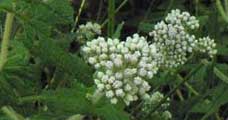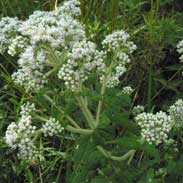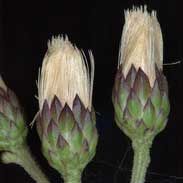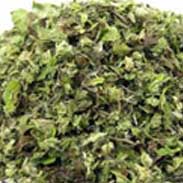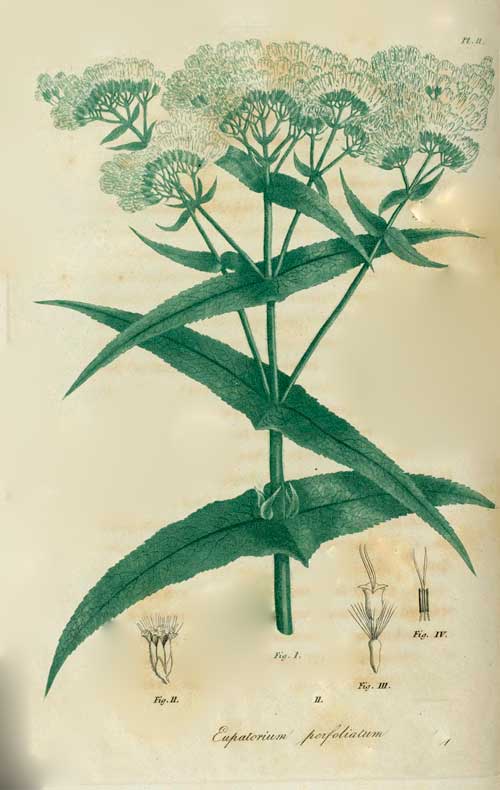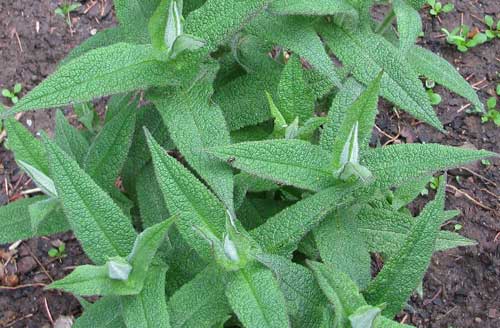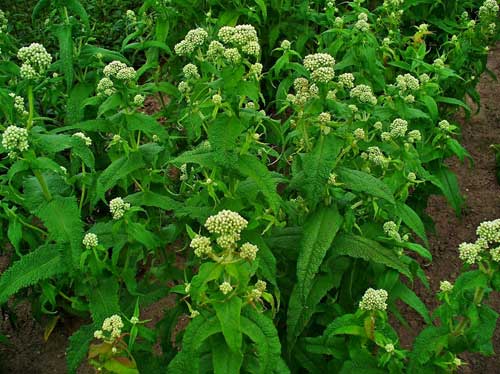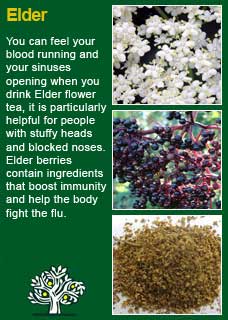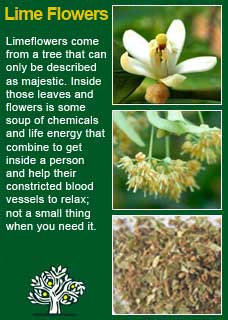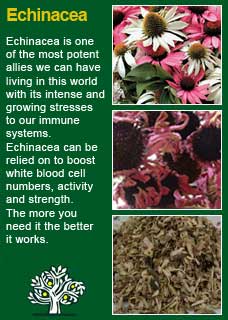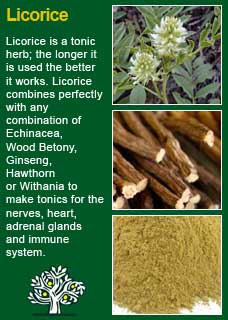
|
|
||||
| Our Pages ABOUT CONSTITUTIONAL MEDICINE
|
The dried leaves of Boneset, a large, long-lived herb which likes to grow in damp, marshy places. This fact was not lost on herbalists of old who saw connections between where a plant grew and how it could best work in the body.
Boneset was a favourite remedy of the Native North American tribes. The Menominees used it to reduce fever, the Iroquois and Mohegans for fever and colds, the Alabamas for upset stomachs and Creeks for body pain. Native Americans also used Boneset for arthritis, indigestion, constipation and loss of appetite. Among European settlers Boneset soon became a popular remedy, in 1887 Dr Millspaugh wrote ''there is probably no plant in American domestic practice that has more extensive or frequent use that Boneset; the attic or woodshed of almost every farm house has bunches hanging from the rafters, ready for immediate use should some family member of neighbour be taken with a cold'. Finlay Ellingwood writes 'Boneset has an undoubted soothing influence upon the nervous system, and is of much value in stomach disorders of nervous origin. In a case of neurasthenia of long standing, complicated with emphysema, the patient, an extremely nervous woman, persistently regurgitated all the food she took. There was no nausea, no vomiting; the food simply came back after it was swallowed. Fifteen drops of the fluid extract of boneset every two hours was given. The second day the patient was relieved, and there was no return of the disorder after the fifth day, for several months, when it recurred for a short time, but was promptly relieved by the same medicine. In a case of intractable hiccough in an old man, when every possible remedy had failed and death seemed inevitable, boneset, fifteen drops in an infusion of capsicum, every hour, produced a permanent cure' David Hoffman says 'Boneset is perhaps the best remedy for influenza' and Simon Mills says 'Boneset provides an excellent diffusion of heat out of the body, particularly useful for respiratory sources of fever, such as influenza and for catarrhal conditions generally'. The British Herbal Pharmacopoeia (BHP) describes Boneset's actions as diaphoretic & aperient and say it is generally indicated for influenza, acute bronchitis and naso-pharyngeal catarrh and specficially indicated for influenza with deep aching and congestion of the respiratory mucosa. The BHP recommending a dose of 1-2 grams by infusion or 1-2 mls of the tincture or extract of Boneset. It is now seldom, or never, used as an emetic chiefly because emetics are not often employed, and also on account of the bitterness of the drug and the quantity of infusion required. Its thoroughness as such, however, cannot be questioned, and it has no poisonous or depressing qualities. Eupatorium is now used in malarial affections of the irregular and masked types, and particularly those not benefited by quinine. The chill and succeeding fever are slight, the skin dry, and not, as a rule, followed by perspiration; there is deepseated, aching pain, as if “in the bones”, praecordial oppression, and great thirst. If, however, the fever lasts all day, slight sweating may occur at night. An added indication in ague is vomiting, especially of much bile. Formerly the hot infusion was given to emeto-catharsis, and followed during the intermission with tonic doses of the cold infusion. This is now known to be unnecessary, full doses, short of nausea, of the alcoholic preparations being fully as efficient. Malarial headache, with irregular intermittence, is also relieved by small doses of the drug. Eupatorium is an admirable remedy “to break up a common cold,” especially when accompanied by deep-seated, aching pain and slight or no fever. If there are pleuritic pain and hoarseness, it is also valuable. In every epidemic of influenza it has been used with great advantage. During the severe pandemic of 1918-19 it was one of the safest and most successful remedies employed and contributed much to the successful management of the disease under Eclectic treatment. By many it came to be used as a prophylactic, persons taking it freely apparently escaping attack. Notwithstanding this, its prophylactic power, if it has any, is as yet unexplained and should not be seriously relied upon. That cases were rendered milder, deep-seated pain promptly relieved, cough and respiratory irritation lessened, and recovery expedited under the liberal administration of eupatorium is a matter of record. It is especially valuable to relieve the intolerable backache and pain in the limbs. It is one of the best of medicines to relieve the irritable cough of measles, but care must be taken not to push its effects to nausea and vomiting. For children it is best administered in an aromatized syrup. In pneumonia it relieves chest pains and cough, and for these purposes may be employed in the early stage of acute lobar, but more effectually in broncho-pneumonia. After the active stages have passed it again becomes useful to allay the irritable after-cough and to assist in expectoration when bronchorrhea occurs. Being tonic and stomachic, when given in small doses it improves the appetite and digestion and thus favors a more rapid and perfect convalescence.
~ European studies show that Boneset helps treat viral and bacterial infections by stimulating white blood cells to destroy disease-causing micro-organisms more effectively. (Habtemariam, S. and Macpherson, A. M. Cytotoxicity and antibacterial activity of ethanol extract from leaves of a herbal drug, boneset (Eupatorium perfoliatum). Phytother Res 2000;14(7):575-577) ~ Another study showed that Boneset has anti-inflammatory properties lending support to its traditional uses. In the Journal of Ethnopharmacology 1st September 2011, Pages 371–381 after testing Boneset via LPS-stimulated RAW 264.7 cells by NO/iNOS quantification, gene array, real-time PCR and ELISA the authors concluded its anti-inflammatory effects can be seen as a verification of the traditional use against inflammatory diseases. ~ In a study, boneset increased the activity of phagocytosis, more so than a pure Echinacea angustifolia mono-extract. (Wagner, H. and Jurcic, K. [Immunologic studies of plant combination preparations. In-vitro and in-vivo studies on the stimulation of phagocytosis]. Arzneimittelforschung 1991;41(10):1072-1076) ~ Boneset contains sesquiterpene lactones, including eupafolin, euperfolitin, eufoliatin, eufoliatorin, euperfolide, eucannabinolide, and helenalin; immunostimulatory polysaccharides, primarily 4-0-methylglucuroxylans; flavonoids, such as quercitin, kaempferol, hyperoside, astragalin, rutin, eupatorin; diterpenes, including dendroidinic acid and hebenolide; sterols; and volatile oil. (Herz, W., Kalyanaraman, P. S., and Ramakrishnan, G. Sesquiterpene lactones of Eupatorium perfoliatum. J Org Chem 6-24-1977;42(13):2264-227) These sequiterpene lactones that stimulate the digestive tract and in larger doses would be expected to help expel parasites. Researcers experimenting with a sequiterpene lactones from Boneset called EVP concluded that it possessed anti-tumour properties. ~ The authors, titles and the 'where-and-when' published of a handful of further studies and articles on Boneset are listed in a PDF found here It is also important to note that if you use too much Boneset then you will quickly feel mild nausea all the way up to vomiting and diarrhoea. The intense bitterness of Boneset warns that this is a herb to treat with respect and not to overdo. Taking too much will quickly trigger a reaction in the stomach, if you are drinking Boneset tea and you feel nausea then stop, it will still act as a potent medicine in low doses and this is your body's way of telling you that you have had enough.
For some years now, against this proven and safe way of herbalism, there has been a rising tide of excessive caution and scare-mongering in many parts of the world. The same authorities that, not so long ago, decried herbal medicines as ineffectual, have now taken up a different adversarial position; that they are dangerous substances that should only be prescribed by Doctors, who of course have zero training in them. Unfortunately, the same unnecessary fear and worry has crept into many natural health websites and popular publications on herbs. Herbs that we have safely used for thousands of years, that have no reports of adverse reactions in the medical literature despite widespread use by millions of people, are suddenly described as contraindicated because of something that should have been seen as completely unimportant, or at the utmost a merely theoretical concern, such as a laboratory study on one of the herb's constituents to use an all too common example. I wonder sometimes if the writers of such articles feel that the herb will be more deserving of respect if it is thought to be a little bit dangerous, in other words more like a drug than something that has simply come out of the earth and been used by ordinary people for generations beyond count. There is just so much misinformation about herbal medicine on the internet now. Ludicrous claims and cautions abound in equal measure; it seems like one group are trying to make money out of the public whilst the other are busily trying to scare them off. I have to believe that the kind of reader who takes the time to read pages on herbs that are as extensive as this one is much less likely to be swayed by marketers or misinformers. I hope that you will keep your wits about you if you get conflicting opinions from people who have never really got to know these herbs, who have never worked with them, or learned how to use them safely and effectively. I want to remind you that the reason that herbs can never be patented and owned by any individual or corporation is because they are, and always will be, the People's medicine. They belong to all of us and it is my great hope in sharing this work that you will learn how to use them wisely for yourself, and the people you care for. Be safe, but do not be afraid.
When I have used Boneset as a tea for severe colds and flus I have found it to be remarkably effective and I most certainly can attest that this herb does help with awful ache in the bones of a bad flu or fever. I also frequently use Boneset as a tonic in immune boosting formulae, albeit in carefully moderate doses, and believe it can convey a singular kind of fast-acting intensity to an immune tonic that has no comparison. The invaluable Echinacea, by comparison, may convey much more widespread benefits to a struggling immunity but combining Boneset with it can get things moving in a positive direction far more quickly than if you didn't think to include it. . Boneset also has a notable cleansing action and can be very useful for conditions where there is too much damp congestion in the body. People with problems such as night sweats, bloating, indigestion, fluid retention or chronic sinus congestion can do particularly well on Boneset. Boneset has an intense and penetrating bitterness; only small doses are needed to achieve its therapeutic effects and in tincture form I probably only look to use around 1 or 2 mls of in a day combined with other herbs as a tonic. In tea form, not much more than a half a tsp or even less will be more than enough for most people to get a strong action from the herb. If you who are reading this are studying herbal medicine then you might want to acquire some Boneset and take a very small dose of its tea or tincture with a quiet and attentive mind so you can experience its qualities for yourself. I think you will find that it reliably produces a rather distinctive 'action' that will give you an appreciation of the herb beyond the limit that an academic understanding can bring you to. Of course, what you feel will be something that only you can know for yourself but the kinds of words that typically get used to describe this herb are penetrating, stimulating, cleansing, activating... Further to this, if you would like to learn more about the ancient art of pulse testing, a simple but powerful way to ask the intuitive intelligence of the body for its responses to a herb by feeling the pulse whilst giving a tiny dose by mouth, read here Boneset combines exceptionally well with Elder flower and Limeflowers for colds and flus and it works perfectly with the great tonic herbs Echinacea and Licorice root for boosting the immune system.
Much of the information here about the traditional uses of Boneset is consistent with the model of thinking whereby one may treat condition A with plant/substance B. There is value in this approach, especially in how it helps us pass on useful knowledge to one another, but it falls short in one vital area; and that is that people are not all cut from the same cloth! Something that works brilliantly for one person may do less for another -- why is this? Part of the reason is that people vary in their constitutions as to whether they are either hotter or cooler and, at the same time, either dryer or damper. This useful and rather fascinating subject is introduced further here Another big part of using the right herb when it is most needed comes from understanding the need to treat what is going wrong for the person that had led up to their getting a health condition. In this light,Boneset can particularly offer its benefits when an activation is needed in the 'cycle of healing' more about that here
Please understand that I cannot advise you, including on products or dosage, without seeing you in person in my clinic but for ideas
on how you might find a good herbalist in your area read here |
|
|
© 2011 R.J.Whelan Ltd
